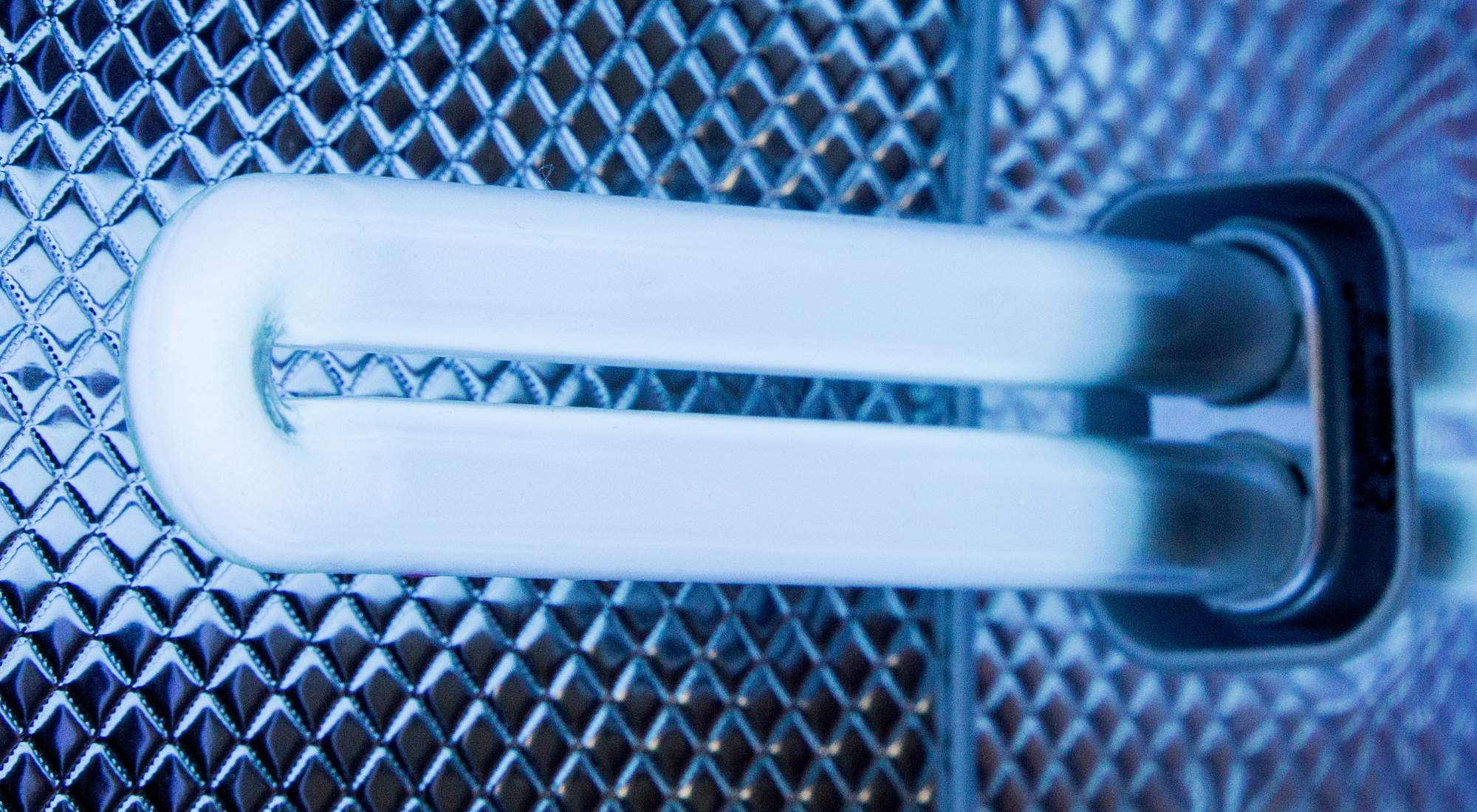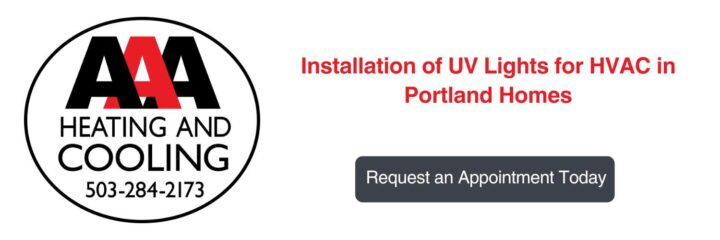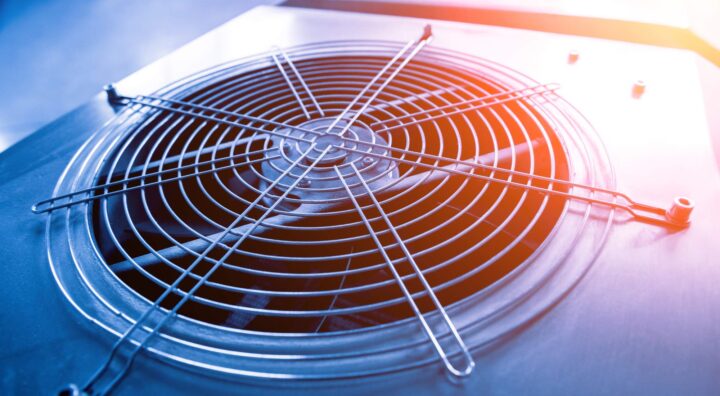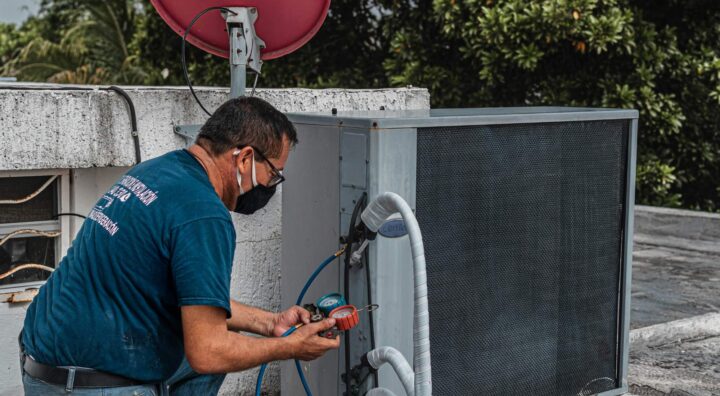
You change your air filters. You dust every week. But the sniffles won’t quit, and the musty smell near the vents keeps coming back.
What you can’t see — mold on the coil or germs in the airflow — might be the problem.
One potential solution: A UV light tucked inside your HVAC system quietly goes to work, zapping microbes, keeping your system clean, and helping you breathe a little easier every day.
But is it worth it?
Looking for ways to improve your home’s indoor air quality? AAA Heating and Cooling will help you consider the benefits of UV lights in your HVAC and explain other technologies and solutions for improving indoor air quality.
Table of Contents
- How Does UV Light for HVAC Work?
- Two Kinds of UV Light for HVAC Systems
- Do UV Lights in HVAC really work?
- Are UV Lights for HVAC Worth It? Weighing the Pros and Cons
- Does Everyone Need UV Lighting for HVAC?
- Considering UV Light for HVAC With AAA Heating and Cooling
How Does UV Light for HVAC Work?
Ultraviolet (UV) light, particularly UV-C rays, is effective at killing microorganisms like bacteria, viruses, and mold spores. UV-C light has a wavelength range of 200 to 280 nanometers and works by damaging the DNA and RNA of microorganisms, rendering them unable to replicate or cause infection. This makes UV-C technology a powerful tool in air purification systems, especially when installed in HVAC units or air purifiers.
UV-C light is just one method of purifying the air. True indoor air quality involves a multi-layered approach, including high-efficiency filters, humidity control, proper ventilation, and regular HVAC maintenance.
That’s where AAA Heating and Cooling, your trusted Portland HVAC company, comes in. Whether you’re interested in learning more about UV light purification, upgrading your HVAC system, or simply improving your home’s air quality, we offer expert guidance and reliable solutions to meet your needs. Let our professionals help you breathe easier year-round.

Two Kinds of UV Light for HVAC Systems
How UV light works in your HVAC system depends on the type installed.
#1: Coil Sanitizing Lights
Coil-sanitizing UV lights are installed right next to your HVAC system’s evaporator coil. This is a damp area where mold and bacteria can easily grow, leading to clogs, odors, and reduced system efficiency.
These lights work by shining directly on the coil 24/7, preventing buildup before it starts. While they don’t purify the air moving through your ducts, they help your system run more smoothly and last longer.
Here’s what coil sanitizing lights do best:
- Prevent mold and bacteria from growing on the coil
- Reduce musty odors caused by microbial buildup
- Help maintain strong airflow and energy efficiency
- Lower the risk of breakdowns and costly repairs
They offer a simple way to protect the heart of your HVAC system and keep it working like it should.
#2: Air Sanitizing Lights
Air-purifying UV lights are installed inside your HVAC ductwork and are designed to clean the air as it flows through your system. Unlike coil-sanitizing lights, they focus on reducing airborne contaminants before they circulate throughout your home.
These lights activate when the system runs, targeting viruses, bacteria, and mold spores in the moving air.
Here’s what air sanitizing UV lights help with:
- Killing or neutralizing airborne germs, viruses, and mold
- Improving indoor air quality for people with allergies or respiratory issues
- Reducing the spread of contaminants throughout your home
- Working alongside your HVAC system without affecting airflow
They’re a great option if you’re looking to improve the quality of the air your family breathes every day.
Do UV Lights in HVAC Really Work?
Ultraviolet-C (UV-C) light has been increasingly recognized as an effective tool for air disinfection in various settings, including hospitals and HVAC systems. However, the effectiveness of UV-C in HVAC systems, particularly in air sanitizing applications, has been a subject of debate.
A study conducted in the Intensive Care Unit of the University Hospital of Lagarto, Brazil, demonstrated the effectiveness of UV-C air disinfection systems installed in HVAC ducts. The installation of six 15W low-vapor-pressure mercury lamps emitting 253.7nm UV-C light significantly reduced the viability of microorganisms circulating in the environment, suggesting that UV-C can effectively inactivate airborne pathogens in hospital settings.
In HVAC systems, UV-C lamps are typically installed in the ductwork to disinfect the air as it passes through. However, the rapid airflow in HVAC systems can limit the exposure time of microorganisms to UV-C light, potentially reducing their effectiveness. A study investigating in-duct UV-C disinfection found that environmental factors such as airflow velocity, relative humidity, and temperature significantly affected the disinfection efficacy. For instance, increasing relative humidity from 50% to 90% reduced the UV-C disinfection efficacy by 40% to 60% for different bacterial species,
While UV-C light has proven effective in various settings, its application in HVAC systems for air sanitization requires careful consideration of environmental factors and system design. In hospital settings, UV-C can be an effective tool for reducing airborne pathogens. In HVAC systems, the rapid airflow may limit the effectiveness of UV-C, and additional measures, such as optimizing airflow and humidity control, may be necessary to enhance its efficacy.
Are UV Lights for HVAC Worth It? Weighing the Pros and Cons
Price
Coil-sanitizing UV lights are generally the more affordable option. The typical unit cost ranges from $100 to $300, with professional installation adding another $100 to $300. Altogether, most homeowners can expect to pay between $200 and $600 for a full setup. Maintenance is relatively simple, with bulb replacements usually needed every one to two years, costing around $50 to $100.
Air-purifying UV lights, on the other hand, tend to cost more. Units typically range from $300 to $600 or more, depending on the brand and features. Professional installation can add another $150 to $400, bringing the total cost to somewhere between $450 and $1,000 or more. Maintenance is a bit more frequent and expensive, with annual bulb replacements costing around $100.
In short, coil-sanitizing lights are more budget-friendly and focus on keeping your system clean and efficient. Air-purifying lights cost more but offer broader benefits for indoor air quality, making them a better choice for households concerned about airborne germs and allergens.

Effectiveness
When choosing UV lights for your HVAC system, it’s important to understand where each type excels.
Coil-sanitizing UV lights:
- Best for improving HVAC system performance
- Prevent mold and bacteria from growing on the evaporator coil
- Help maintain airflow and energy efficiency
- Ideal if looking to reduce maintenance and keep the system running longer
- Do not clean the air or remove allergens like dust or pet dander
Air-purifying UV lights:
- Best for improving indoor air quality
- Target airborne germs, viruses, and mold spores ductwork
- A smart choice for homes with allergies or respiratory concerns
- Help reduce the spread of illness by neutralizing microorganisms in the air
- Do not filter out dust, pollen, or dander, and should be used along with a good air filter
Think of both types of UV lights as a helpful add-on to your HVAC system. They work best when combined with proper filtration and regular maintenance.
Maintenance
Maintenance for coil-sanitizing lights is generally straightforward. Bulbs usually need to be replaced every 1 to 2 years, and keeping the coil clean helps the system run efficiently. Because these lights focus on a fixed spot, they tend to have a longer effective lifespan and fewer complications. However, regular checks are important to ensure the light is properly positioned and functioning.
Air-purifying lights often require more frequent maintenance since they operate inside the ductwork and work on the moving air. Bulbs typically need annual replacement, and their effectiveness can be influenced by airflow, humidity, and dust buildup on the bulbs. Because they cover a larger area and work continuously when the system runs, keeping them clean and properly functioning requires more attention and sometimes professional servicing.
Installation
Hiring a pro ensures the UV lights are installed correctly and safely, minimizing the risk of damage to your HVAC unit or ductwork. Professionals know exactly where and how to place the lights for maximum effectiveness, and they handle wiring and any necessary system modifications. While it costs more upfront, it can save you from costly mistakes or repairs down the line.
If you’re comfortable with basic electrical work and handy with tools, DIY installation might save you money. However, installing UV lights requires cutting into your HVAC system or ducts, which carries a risk of damaging components or causing leaks. Mistakes could reduce your system’s efficiency or even void warranties. So, DIY is only recommended if you have experience and are confident in your skills.

Does Everyone Need UV Lighting for HVAC?
If you or a loved one suffers from asthma, allergies, or other respiratory issues, improving indoor air quality is crucial. UV light technology can be particularly beneficial in these cases as it can help neutralize airborne pathogens, mold spores, and allergens, reducing triggers that exacerbate respiratory conditions.
Americans spend the majority of their time indoors, with increased time spent at home since the COVID-19 pandemic. This prolonged exposure to indoor air makes ensuring optimal air quality within our homes essential. UV-C lights can play a role in this by targeting and neutralizing airborne contaminants, contributing to a healthier indoor environment.
While UV-C lights can be effective, they are most beneficial when used in conjunction with other air purification methods.
At AAA Heating and Cooling in Portland, we offer comprehensive indoor air quality services, including duct cleaning, filtration solutions, and humidification systems. Our team can assess your home’s air quality needs and recommend the best solutions to ensure a healthier living environment.

Duct Cleaning
Over time, your home’s air ducts can collect dust, pet hair, mold, and other debris that gets circulated every time your HVAC system runs. This buildup doesn’t just sit quietly, it can contribute to poor indoor air quality, aggravate allergies, and create musty odors throughout your home.
Professional duct cleaning removes these hidden contaminants, helping to reduce airborne particles and improve the overall cleanliness of the air you breathe. It can also help your HVAC system work more efficiently by restoring full airflow through clean ducts.
At AAA Heating and Cooling, our expert technicians use industry-leading equipment to thoroughly clean your ductwork and help restore healthy air circulation in your home. Whether you’re tackling allergy symptoms or just want a fresher, cleaner living space, duct cleaning is a smart step toward better indoor air quality.
Filtration
Air filtration is one of the most effective ways to improve your home’s indoor air quality. A high-quality filter traps airborne particles like dust, pollen, pet dander, and even some bacteria and viruses, before they have a chance to circulate through your vents.
For families with allergies or respiratory issues, upgrading to a better filter can make a noticeable difference in day-to-day comfort.
At AAA Heating and Cooling, we help homeowners choose the right filtration system for their needs, whether it’s a high-efficiency filter or a whole-home air purifier. Cleaner air means fewer allergens, a healthier home environment, and a heating and cooling system that runs more smoothly and efficiently.
Humidification
Maintaining proper humidity levels in your home is key to preventing mold and bacterial growth. When the air is too dry or too damp, it creates the perfect environment for these unwanted microbes to thrive.
A whole-home humidifier helps keep indoor humidity balanced, usually between 30% and 50%, which makes it much harder for mold and bacteria to grow on surfaces and inside your HVAC system.
By controlling moisture with a humidifier, you reduce the risk of mold buildup that UV lights are designed to combat. This doesn’t always eliminate the need for UV lights entirely, but it can make their job easier and less urgent. Keeping humidity in check is a natural, proactive step toward healthier air and a cleaner, more efficient HVAC system.
Considering UV Light for HVAC With AAA Heating and Cooling
Keeping your HVAC system in top shape and ensuring the air in your home is safe and comfortable can feel overwhelming, but you don’t have to navigate it alone.
At AAA Heating and Cooling in Portland, our experienced team is here to help you make the best decisions for your unique needs. From expert maintenance and duct cleaning to advanced filtration and humidification solutions, we provide the guidance and services that keep your system running efficiently and your indoor air fresh and healthy.
Don’t wait to breathe easier and enjoy a more comfortable home. Contact AAA Heating and Cooling today to schedule an assessment and discover how we can help you create the perfect indoor environment for your family.
